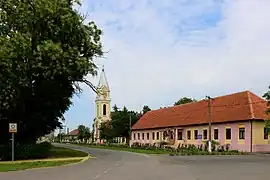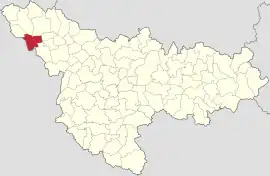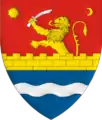Teremia Mare
Teremia Mare (German: Marienfeld; Hungarian: Máriafölde; Serbian: Велика Теремија, romanized: Velika Teremija) is a commune in Timiș County, Romania. It is composed of three villages: Nerău, Teremia Mare (commune seat) and Teremia Mică.
Teremia Mare | |
|---|---|
 The historical rural ensemble of the market area and the park | |
 Location in Timiș County | |
 Teremia Mare Location in Romania | |
| Coordinates: 45°56′N 20°31′E | |
| Country | Romania |
| County | Timiș |
| Government | |
| • Mayor (2020–2024) | Cornel Vasile Gui[1] (PNL) |
| Area | 89.99 km2 (34.75 sq mi) |
| Population (2021-12-01)[3] | 3,603 |
| • Density | 40/km2 (100/sq mi) |
| Time zone | EET/EEST (UTC+2/+3) |
| Postal code | 307405–307407 |
| Vehicle reg. | TM |
| Website | www |
Name
| Romanian | Hungarian | German | Serbian |
|---|---|---|---|
| Nerău | Nyerő, Dugoszelló | Nerau, Dugusell | Дуго Село/Dugo Selo |
| Teremia Mare | Máriafölde, Nagyteremia | Marienfeld, Großtermin | Велика Теремија/Velika Teremija |
| Teremia Mică | Teremi, Kisteremia | Albrechtsflor, Kleintermin | Мала Теремија/Mala Teremija |
History
The first recorded mention of Teremia Mare dates from 1256, under the name of Teremteluk.[4] Between 1769 and 1770, the locality was re-established by colonization with Germans (Swabians) from Alsace and Württemberg. It formed a common colony with Teremia Mică, Comloș and Tomnatic. The Catholic church and the school were built in 1770. The Germans called the village Marienfeld or Großteremin. In 1785 it was bought by Cristofor Nakó, and in 1835 it became the property of Ioan Nakó.
In the interwar period it was part of Plasa Comloșu Mare, Timiș-Torontal County and was a German locality, with very few Romanians and Hungarians. After World War II, the Germans began to leave the locality. Gradually, the Romanians take their place. Immediately after the 1989 revolution, the mass exodus of the Germans took place, so that Teremia Mare became a majority Romanian locality.
Demographics
Teremia Mare had a population of 4,019 inhabitants at the 2011 census, down 3% from the 2002 census. Most inhabitants are Romanians (86.04%), larger minorities being represented by Hungarians (4.4%), Roma (1.64%) and Germans (1%). For 6.15% of the population, ethnicity is unknown.[5] By religion, most inhabitants are Orthodox (77.78%), but there are also minorities of Roman Catholics (6.54%), Pentecostals (4.98%), Baptists (1.82%), Jehovah's Witnesses (1.12%) and Reformed (1.09%). For 6.15% of the population, religious affiliation is unknown.[6]
| Census[7] | Ethnic composition | |||||
|---|---|---|---|---|---|---|
| Year | Population | Romanians | Hungarians | Germans | Roma | Bulgarians |
| 1880 | 5,153 | 943 | 39 | 4,152 | – | – |
| 1890 | 5,715 | 966 | 101 | 4,610 | – | – |
| 1900 | 5,322 | 1,031 | 72 | 4,178 | – | – |
| 1910 | 5,497 | 973 | 204 | 4,253 | – | – |
| 1920 | 5,831 | 1,039 | 130 | 4,606 | – | – |
| 1930 | 5,710 | 1,075 | 147 | 4,398 | 56 | 6 |
| 1941 | 6,258 | 1,550 | 264 | 4,318 | – | – |
| 1956 | 5,470 | 1,999 | 352 | 2,937 | 115 | 52 |
| 1966 | 5,434 | 2,282 | 310 | 2,673 | 62 | 87 |
| 1977 | 4,544 | 2,265 | 296 | 1,842 | 109 | 20 |
| 1992 | 3,871 | 3,208 | 330 | 172 | 105 | 18 |
| 2002 | 4,148 | 3,652 | 280 | 78 | 105 | 7 |
| 2011 | 4,019 | 3,458 | 177 | 40 | 66 | 4 |
Economy

Teremia Mare is a winegrowing community and is known for its high-quality red wine and brandy, the Marienfelder Cognac. Viticulture and winemaking are the most important industries in Teremia Mare. However, growing cereals and vegetables are also of economic importance.[8]
Teremia Mare also became known for the healing thermal water, which is mainly used for rheumatic diseases. The thermal bath was built after a thermal spring was found in 1972 while searching for oil.
Notable people
- Hansi Schmidt (1942–2023), handball player[9]
References
- "Results of the 2020 local elections". Central Electoral Bureau. Retrieved 16 June 2021.
- "Primăria Teremia Mare". Ghidul Primăriilor.
- "Populaţia rezidentă după grupa de vârstă, pe județe și municipii, orașe, comune, la 1 decembrie 2021" (XLS). National Institute of Statistics.
- Szabó, M. Attila (2003). Erdély, Bánság és Partium történeti és közigazgatási helységnévtára. Miercurea Ciuc: Pro-Print Kiadó.
- "Tab8. Populația stabilă după etnie – județe, municipii, orașe, comune". Institutul Național de Statistică.
- "Tab13. Populația stabilă după religie – județe, municipii, orașe, comune". Institutul Național de Statistică.
- Varga, E. Árpád. "Temes megye településeinek etnikai (anyanyelvi/nemzetiségi) adatai 1880-2002" (PDF).
- "Prezentare locală". Primăria comunei Teremia Mare.
- "Hansi Schmidt ist tot: Trauer um Weltklasse-Handballer". FAZ.NET (in German). 2023-02-07. ISSN 0174-4909. Retrieved 2023-10-02.
